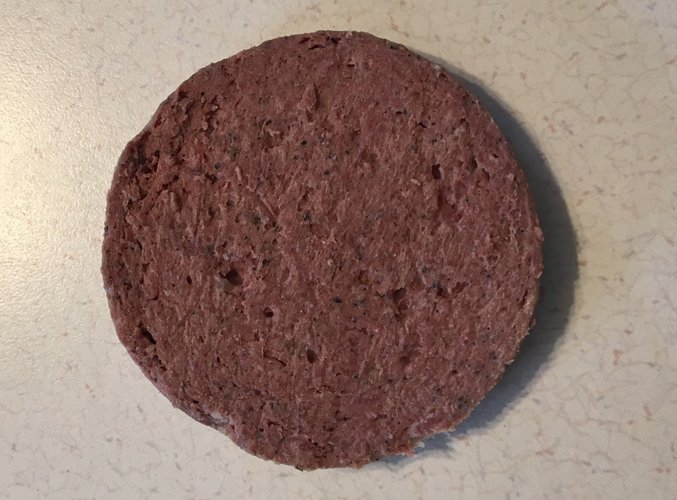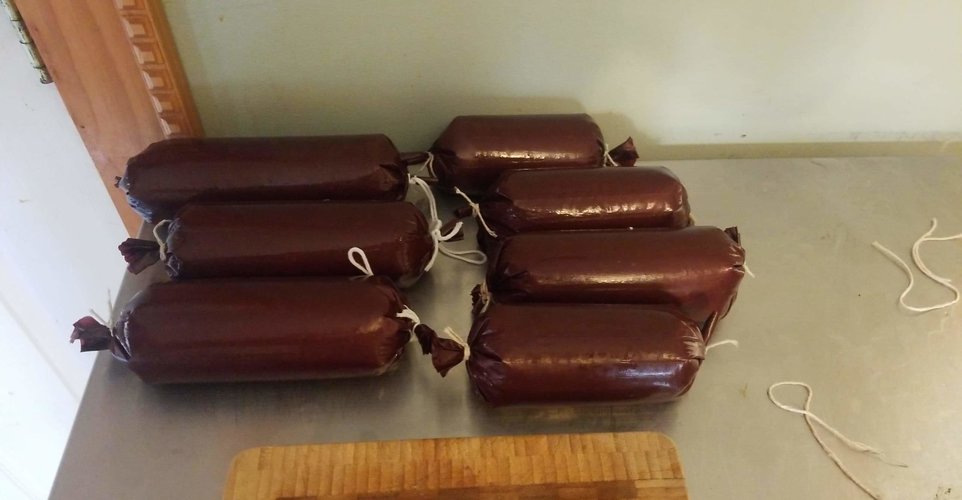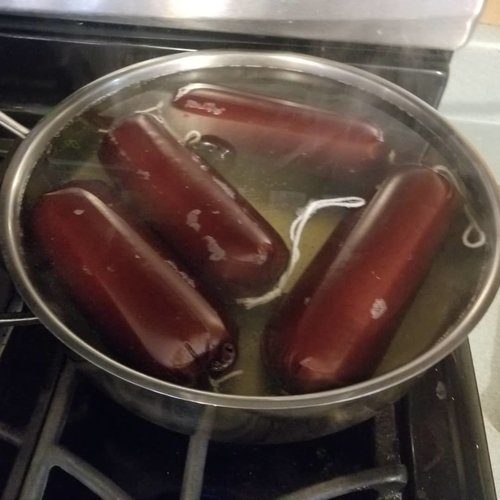WyoDoug
Well-known member
Since I am typically the only one in the family that will eat liver, I often have a bunch leftover liver. To take care of that, I found a recipe for making venison liverwurst. And damn good too. Because of this I now collect all the livers that are not shot up from all the people in my hunt group too. I use the same casings that I make summer sausage with.
Prepare your casings per manufacturers recommendation before starting. Synthetic and natural hog casings should be soaked and cleaned well before starting sausages. I use the largest callogen casings which are ready to go right out of the package and don't need soaking or additional cleaning. The great 2 1/2+ inch big synthetic ones for summer sausage style should be soaked for a good 12 hours.
Process:
A hint: Keep anything that will be in contact with meat as cold as possible. I keep the knives and grinding plates in the freezer until ready to use. Meat should be just above freezing (32 or so) but not solid frozen. Some water crystals on the meat is acceptable. Pork fat must be cold or it will stick together and become kind of gummy and hard to work with.
I will usually start with a whole pork shoulder, so I’ll cut it all up into cubes and run it through the grinder once. If you use a pork butt, try to get the type with the fat cap still on. Then I’ll take what I need from that. Put it in a bowl with the diced liver and all the other ingredients, and mix thoroughly. Run this mixture through the grinder one more time with a fine blade. Remember, you do not want particle definition with pork fat so I grind it finer than I do the liver. Otherwise you end up with a wad of fat or meat drizzling in fat when you cook it.
Move the mixture to the mixer and add both the curing salt and the encapsulated citric acid. If you do not have a mixer, mix it by hand until you have protein extraction. This will take a lot longer to do it by hand. You can use a blender but you will have to process a pound or so of the mixture at a time. Be careful about overworking meat mixture in a blender because it gets much harder to work with. What you want to achieve is protein extraction which occurs when the meat becomes elastic and sticks together but thin and pliable enough to go through your sausage stuffer. You want this mixture to be very cold but not froze solid to go through the stuffer. Chill for about 30 minutes or so. As the mixture warms, it gets harder to work with. Plus this lets the flavors infuse for a little while.
Taking one fourth to one half of the mixture at a time, run it through the food processor till it get’s a nice creamy texture. The whole batch may fit in your processor, but most likely it will be too much all at once for your processor to handle smoothly. Ball it up and put into your sausage stuffer.
Stuff the mixture into a 2 1/2 inch casing of your choice. I always have Weston callogen casings on hand for summer sausage, and they work great for liverwurst too. The 20″ x 2 1/2″ will hold close to 3 lbs of meat, so this batch should fit perfectly in one casing. Tie off the end tightly enough to keep it from leaking using string or hognose staples.
In a the oven or smoker I set it to cook in the following cycles (same as for summer sausage). I do not smoke liverworst, just my preference.
When it’s done, pull it from the smoker or oven and dip it in an ice bath to stop the cooking process. These are fully cooked and can be eaten as snack or lightly fry them and use them for breakfast. Hang to dry and then vacumn seal and put in freezer. These come out similar to summer sausage but with the liverwurst taste to it.
Warning on smoke: A little goes a long ways. Too much smoke gives meat kind of an acidic taste and can become an unpleasant experience. Don't overdo it.
Prepare your casings per manufacturers recommendation before starting. Synthetic and natural hog casings should be soaked and cleaned well before starting sausages. I use the largest callogen casings which are ready to go right out of the package and don't need soaking or additional cleaning. The great 2 1/2+ inch big synthetic ones for summer sausage style should be soaked for a good 12 hours.
- 1 lb of diced deer liver
- 1.5 lbs of ground pork
- 1 small to medium onion, grated
- 1 tablespoon of kosher salt
- 1 teaspoon of ground black pepper
- 1/2 teaspoon of dried oregano
- 1/2 teaspoon of dried sage
- 1/2 teaspoon of dried thyme
- 1/2 teaspoon of allspice
- 1/4 tsp #2 pink curing salt (sodium nitrite)
- 2 oz encapsulated citric acid (cure accelerator) (measure on a scale if you got it to 142 grams)
- If mixture appears dry, add 1 tablespoon of very ice water until mix bonds and you start achieving protein extraction. You are working with liver which typically is not very dry so you should not need to add water.
Process:
A hint: Keep anything that will be in contact with meat as cold as possible. I keep the knives and grinding plates in the freezer until ready to use. Meat should be just above freezing (32 or so) but not solid frozen. Some water crystals on the meat is acceptable. Pork fat must be cold or it will stick together and become kind of gummy and hard to work with.
I will usually start with a whole pork shoulder, so I’ll cut it all up into cubes and run it through the grinder once. If you use a pork butt, try to get the type with the fat cap still on. Then I’ll take what I need from that. Put it in a bowl with the diced liver and all the other ingredients, and mix thoroughly. Run this mixture through the grinder one more time with a fine blade. Remember, you do not want particle definition with pork fat so I grind it finer than I do the liver. Otherwise you end up with a wad of fat or meat drizzling in fat when you cook it.
Move the mixture to the mixer and add both the curing salt and the encapsulated citric acid. If you do not have a mixer, mix it by hand until you have protein extraction. This will take a lot longer to do it by hand. You can use a blender but you will have to process a pound or so of the mixture at a time. Be careful about overworking meat mixture in a blender because it gets much harder to work with. What you want to achieve is protein extraction which occurs when the meat becomes elastic and sticks together but thin and pliable enough to go through your sausage stuffer. You want this mixture to be very cold but not froze solid to go through the stuffer. Chill for about 30 minutes or so. As the mixture warms, it gets harder to work with. Plus this lets the flavors infuse for a little while.
Taking one fourth to one half of the mixture at a time, run it through the food processor till it get’s a nice creamy texture. The whole batch may fit in your processor, but most likely it will be too much all at once for your processor to handle smoothly. Ball it up and put into your sausage stuffer.
Stuff the mixture into a 2 1/2 inch casing of your choice. I always have Weston callogen casings on hand for summer sausage, and they work great for liverwurst too. The 20″ x 2 1/2″ will hold close to 3 lbs of meat, so this batch should fit perfectly in one casing. Tie off the end tightly enough to keep it from leaking using string or hognose staples.
In a the oven or smoker I set it to cook in the following cycles (same as for summer sausage). I do not smoke liverworst, just my preference.
- One hour at 120 degrees
- two hours at 145 degrees (introduce smoke here if desired)
- two hours at 175 degrees or until internal temp reaches 160 degrees
When it’s done, pull it from the smoker or oven and dip it in an ice bath to stop the cooking process. These are fully cooked and can be eaten as snack or lightly fry them and use them for breakfast. Hang to dry and then vacumn seal and put in freezer. These come out similar to summer sausage but with the liverwurst taste to it.
Warning on smoke: A little goes a long ways. Too much smoke gives meat kind of an acidic taste and can become an unpleasant experience. Don't overdo it.
Last edited:







